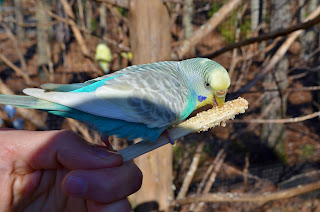Two chicks had just hatched from their eggs and another one was working at it. There was a small hole in the egg and we could see him pecking at it, breaking his way out. Outside, we walked around the multinational exhibit, a large pond with many ducks, geese, and other waterfowl. Then we headed into the Landing Zone, the highlight of the tour. We bought some seed sticks and bags of duck food to feed the birds in here.
Flying around the enclosure were a number of budgerigar parakeets. All we had to do was hold up a seed stick and one or two would land on our hands and start eating the seeds. Sometimes, the birds were not in a sharing mood and one would chase the other one off and have the seed stick to herself.
Once the parakeets had cleaned off all the seed from the sticks, we headed to the other side of the exhibit where the American flamingos were standing in a shallow pool of water.
We bought some bags of duck pellets to feed the flamingos.
They seemed to be well fed as most weren’t interested in the food, but rather honking at each other and fighting to determine the pecking order of the flock. However, there were a few hungry flamingos more interested in food than with conflicts within the flock. Feeding these birds was quite an experience. I had seen flamingos plenty of times in the past, but this was the first time for an up-close encounter. Their curved beaks are lined with what looked like tiny little teeth, but I think they were for straining food out of shallow water. The birds also didn’t seem to like to eat dry food - they would either drop the food into the water or spit water into my hand before eating the pellets. Truly fascinating birds!
After we finished feeding the flamingos, we left the Landing Zone exhibit and continued touring the park. We walked past the South America exhibit, but most of these birds had been taken in from the cold. We walked around the far end of the park to the Beaver Pond Blind and Treehouse, but there wasn’t a lot to see here, so we continued back to the North America exhibit.
There were a lot of various ducks and geese here, as well as some beautiful cranes and geese.
One whooping crane was very interested in the GoPro camera and even tried to take a bite! The demoiselle cranes were especially beautiful with light grey-blue feathers and a plume of darker feathers running down their chests.
In the Eurasian birds exhibit, there were many different species of duck. The red-crested pochard were really cool looking, with big orange feathers on their heads, looking like some wild slicked-back hairdo.
Continuing on, we stopped at the flamingo exhibit to see the Chilean and lesser flamingos, and right past this exhibit was the Eurasian eagle-owls.
A pair of these owls were watching us intently, one with an angry look and the other looking more surprised. In the pheasant aviary, a male Indian peacock was in full display with his beautiful covert feathers up.
Unfortunately, behind the fence, it was tough to get a good picture. Next, we stopped to see the emu who got very excited by our presence. He seemed to take quite a liking to John! Continuing on, we stopped for a while at the exotic birds exhibits.
There were many beautiful and strange-looking birds here, including a helmeted curassow, burrowing owls, a red-wattled curassow, and a toco toucan.
Near the end of this exhibit, we stopped to see the laughing kookaburras. They didn’t seem to be in a singing mood, so Justine looked up their call on her phone and played it for them.
Once they heard it, they flew together from opposite sides of the cage and began singing their little hearts out. It was really exciting to watch them sing. And they had to be next to each other when they sang; I guess they didn't want to sing alone. Each time they started singing, they would fly over and perch next to each other, sing for a minute or so, then fly back apart.
Their songs are used to establish territory so perhaps when they heard the song from the phone, they thought some other birds were trying to encroach on their spot. We finished touring the area by checking out the Africa and Eurasia exhibits as we made our way back to the office.
The Abyssinian ground hornbill from Africa was a particularly fascinating looking bird.
It was all black with what looked like a broken horn on top of his beak and long eyelashes. A truly bizarre-looking creature!
We also saw more geese and ducks, including the beautiful Mandarin ducks, before heading back. From the park, we headed into Scotland Neck for lunch at La Casetta. It was right on Main Street and we parked in the middle of the street, between the two opposing lanes of traffic. After lunch, we started heading back. To break up the drive and get a little exercise, we stopped at Medoc Mountain State Park on the way home.
It was getting late and we didn’t have a lot of time, so we parked at the picnic area and hiked about 3 miles on the Bluff Loop Trail with nice views along Little Fishing Creek.
Once we finished, we started making our way back home.





















No comments:
Post a Comment